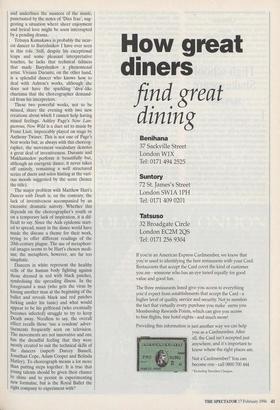Dance
Royal Ballet's Quadruple Bill (Royal Opera House)
Sexual mores
Giannandrea Poesio
Choreographic revivals are often prob- lematic and risky. Despite complex issues such as authenticity and reconstruction, past works that have been either successful or controversial often appear dated and insipid to contemporary audiences. Fortu- nately, this is not the case with Kenneth MacMillan's The Invitation, currently per- formed by the Royal Ballet.
When it was created in 1960, the work received mixed reactions — for sexual abuse was not a common balletic theme at the time. But by developing the dramatic formulae previously expounded in The Bur- row (1958), MacMillan broke new ground and demonstrated that harsh reality could provide the subject for narrative choreog- raphy. None of the ballet's original compo- nents seems to have lost its aggressive, erosive quality, and the crescendo of dra- matic tension still captures the audience's attention despite the ballet being 58 min- utes long — there are, in total honesty, a few weary moments, though. The opening night saw a perfect cast led by a powerful Irek Mukhamedov and an ambiguous Gen- esia Rosato as the (brutal) initiators of the two adolescents, although Leanne Ben- jamin and Stuart Cassidy appeared slightly too mature as the young cousins coming to terms with sexual awakening.
It was quite a contrast with the opening piece, Frederick Ashton's Rhapsody. Creat- ed in 1980 for the Queen Mother's 80th birthday, this ballet summarises the charac- teristics of Ashton's other symphonic bal- lets. As in Symphonic Variations and Birthday Offering, the accurate reading of the score, by Rachmaninov (the same he had used for the ballet sequence in the tear-jerker film Stories of Three Loves danced by Moira Shearer), results in an astonishing yet refined coloratura of steps.
The ballet was created for the Royal Bal- let's ballerina Lesley Collier and the flam- boyant Russian star Mikhael Baryshnikov (who never felt at ease with the choreogra- phy) and focuses on fast, neat footwork for the female dancer — a characteristic of Ashton's style — and pyrotechnical solu- tions for her partner. Neither the intrica- cies of the floor patterns nor the virtuoso parts, however, are gratuitous and they do not detract from the artistic content of the dance; the choreographic imagery matches and underlines the nuances of the music, punctuated by the notes of 'Dies Irae', sug- gesting a situation where sheer enjoyment and lyrical love might be soon interrupted by a pending drama.
Tetsuya Kumakawa is probably the near- est dancer to Baryshnikov I have ever seen in this role. Still, despite his exceptional leaps and some pleasant interpretative touches, he lacks that technical tidiness that made Baryshnikov a phenomenal artist. Viviana Durante, on the other hand, is a splendid dancer who knows how to deal with Ashton's works, although she does not have the sparkling 'diva'-like charisma that the choreographer demand- ed from his interpreters.
These two powerful works, not to be missed, share the evening with two new creations about which I cannot help having mixed feelings. Ashley Page's Now Lan- guorous, Now Wild is a duet set to music by Franz Liszt, impeccably played on stage by Anthony Twiner. This is not one of Page's best works but, as always with this choreog- rapher, the movement vocabulary denotes a great deal of inventiveness. Durante and Mukhamedov perform it beautifully but, although an energetic dance, it never takes off entirely, remaining a well structured series of duets and solos hinting at the vari- ous moods suggested by the score (hence the title).
The major problem with Matthew Hart's Dances with Death is, on the contrary, the lack of inventiveness accompanied by an excessive dramatic naivety. Whether this depends on the choreographer's youth or on a temporary lack of inspiration, it is dif- ficult to say. Since the Aids epidemic start- ed to spread, many in the dance world have made the disease a theme for their work, trying to offer different readings of the 20th-century plague. The use of metaphori- cal images seems to be Hart's chosen medi- um; the metaphors, however, are far too simplistic.
Dancers in white represent the healthy cells of the human body fighting against those dressed in red with black patches, symbolising the spreading illness. In the foreground a man (who gets the virus by kissing another man at the beginning of the ballet and reveals black and red patches lurking under his tunic) and what would appear to be his girlfriend (who eventually becomes infected) struggle to try to keep Death away. Needless to say, the overall effect recalls those 'use a condom' adver- tisements frequently seen on television. The movements are not innovative and one has the dreadful feeling that they were mostly created to suit the technical skills of the dancers (superb Darcey Bussell, Jonathan Cope, Adam Cooper and Belinda Hatley). To choreograph means a lot more than putting steps together. It is true that Young talents should be given their chance to shine and to persist in experimenting flew formulae, but is the Royal Ballet the right company to experiment with?



























































 Previous page
Previous page